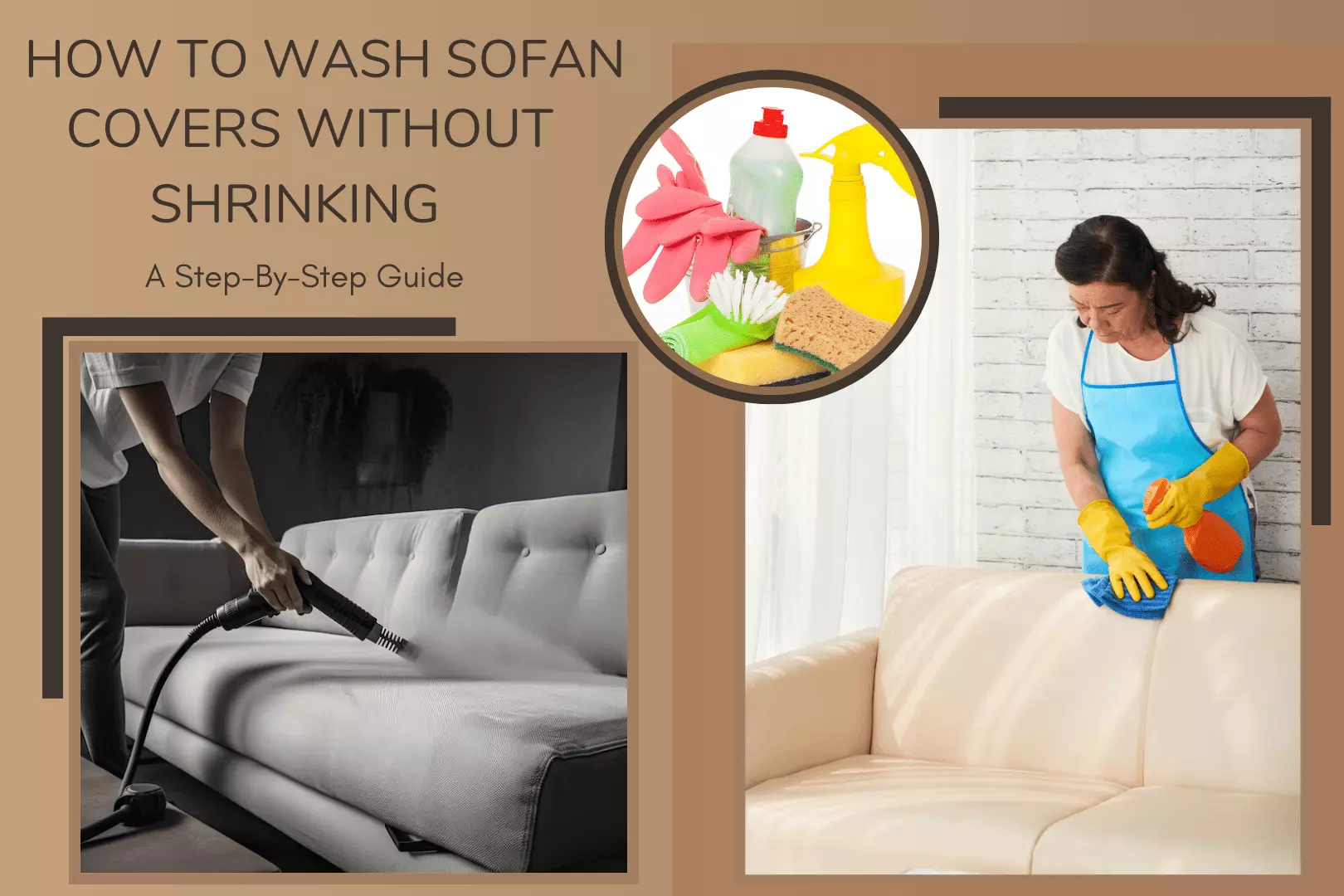Sofas are the centerpiece of many living rooms, offering comfort and style. However, with regular use, they can quickly accumulate dirt, stains, and wear. Whether you have removable slipcovers or fixed upholstery, knowing how to wash sofa covers without shrinking effectively is essential to maintain their appearance and prolong their lifespan.
In this guide, we’ll explore various methods to ensure your sofa remains fresh, clean, and inviting.
Steps to Wash Sofa Covers Without Shrinking

1. Understanding the Fabric
Before diving into the washing process, it’s crucial to understand the fabric of your sofa cover. Different materials have unique care requirements. Check the label for specific instructions. If unsure, Consumer Reports offers an extensive guide on fabric care.
2. Pre-wash Preparations
- Spot Cleaning: Address any stains or spills immediately. Use a mild detergent or specialized cleaner, depending on the type of stain.
- Cold Water: Always opt for cold water. It’s gentler on fabrics and significantly reduces the risk of shrinking.
3.Washing Techniques
- Hand Wash: If possible, hand wash your sofa covers. This method is the gentlest, ensuring the fabric remains intact. Use a mild detergent and avoid wringing the fabric.
- Machine Wash: If you must use a machine, select the delicate cycle. Add a cup of white vinegar to the wash; it acts as a natural fabric softener and helps maintain the fabric’s integrity. Good Housekeeping provides an in-depth guide on machine washing delicate items.
4. Drying and Post-care

- Air Dry: The best way to dry sofa covers is to let them air dry. Lay them flat on a clean surface, away from direct sunlight to prevent fading.
- Avoid Tumble Drying: If you’re in a hurry, use the tumble dryer’s lowest heat setting. However, air drying remains the safest bet.
- Ironing: If your sofa covers are wrinkled, iron them inside out on a low setting.
Read More: How to Create a Foyer in an Open Living Room
Types of Sofa Covers
Cotton and Linen Covers: Natural Comfort

Sofas with coverings made of natural materials like cotton or linen are highly prized. Produced from natural resources, such fabrics provide a soft, cool, and breathable touch, ideal for the warmer months. Unfortunately, due to the nature of their fibers, they tend to wrinkle readily. They might also shrink if not maintained properly. If you want to keep them in excellent condition, you must strictly adhere to the cleaning directions.
Polyester and Microfiber Covers: Durable and User-Friendly

Polyester and microfiber are two examples of resilient synthetics. These covers are great for homes with kids and dogs since they can withstand spills, creases, and sun damage. They last for years despite constant usage since they need no upkeep and are quite sturdy.
Leather and Faux Leather Covers: Luxurious Elegance

Both genuine leather and its synthetic equivalent, fake leather, are synonymous with elegance and class. They are resilient and simple to clean, needing just a wipe for most spills, in addition to their elegant look. Covers made from these materials may be more costly than cloth ones, and they may need specific chemicals to keep their shine and avoid breaking over time.
Velvet Covers: Plush Sophistication

Add a touch of class and sophistication to your living room with velvet couch coverings. Their velvety feel and shiny shine make them stand out, transforming a regular couch into a conversation starter. While velvet coverings are unquestionably sophisticated, they may need more regular washing in order to keep their plush look.
Stretch Covers: Tailored Flexibility

Stretch covers, often made from spandex and polyester, are made to conform closely to the shape of a couch. This guarantees a flawlessly fitted appearance with no slack or drooping fabric. Those that value form and function equally often choose for them because of how simple they are to set up and take down.
Read More: How to Hide Fridge in Living Room
How to Wash Sofa Covers That Don’t Come Off

Sofas with coverings that are permanently attached need a different strategy. To begin, remove any dust or loose dirt from the couch by vacuuming it. Get together some water and a little amount of mild liquid detergent and use that.
Soak a sponge or towel in the solution and squeeze out the excess water. Pay special attention to any filthy or stained sections of the couch and blot or clean them gently. Scrubbing too harshly might ruin the cloth, so be careful.
After you’ve finished cleaning, use a moist towel to remove any soap residue from the couch. Before using the couch again, make sure it has dried fully. After the couch has dried, you may give it a gentle spritz with a fabric refresher for extra fragrance.
How To Wash Sofa Covers At Home

It is more practical and cost-effective to wash couch coverings at home. First, examine the tag for any further cleaning instructions. Use a lint roller or vacuum to get rid of any stray hairs and other loose particles from the covers.
Use a moderate detergent or stain remover to pre-treat any stains. To wash delicate, fill a bathtub or basin with cold water and add a little amount of mild detergent. To clean the couch cover, submerge it in water and swish it around with your hands.
You may let it sit for up to 30 minutes in the water. You should wash it in cold water to remove the detergent. Without wringing, gently squeeze out the excess water, and place the cover flat on a dry cloth to dry.
Read More: How to Decorate a Rectangular Living Room
Washing Couch Cushion Covers In Washing Machine

Couch cover slipcovers may be machine washed for your convenience. Make sure the cloth can be washed in a machine by checking the label first. Take out the hair and solid waste. Use a proper stain remover to pre-treat stains. The outside fabric of the covers may be preserved by turning them inside out.
Don’t overstuff the washer however; just throw them in there. Wash in cold water using a moderate detergent on the gentle cycle. Immediately after the cycle ends, remove the covers to avoid creasing the clothes. Covers should be dried by putting them flat to dry in the air, or tumble dried on a low heat setting if the label specifies this.
Dry Cleaning Sofa Covers

Some sofa covers, especially those made of delicate or specialty fabrics, may require dry cleaning. This method uses solvents to clean the fabric without using water, ensuring the material remains undamaged. If your sofa cover label indicates “Dry Clean Only,” it’s crucial to adhere to this instruction.
Take the covers to a reputable dry cleaner who can handle them with care. After dry cleaning, ensure the covers are completely free from any solvent odor before placing them back on your sofa.
Read More: Does the Living Room have Two Windows
Conclusion
Maintaining the cleanliness and integrity of your sofa covers is paramount to ensuring a cozy and aesthetically pleasing living space. Whether you’re dealing with fixed upholstery, removable slipcovers, or specialty fabrics, each requires a unique approach to cleaning.
By understanding and implementing the methods outlined in this guide, you can ensure that your sofa remains a welcoming centerpiece in your home for years to come. Regular care not only enhances the appearance but also extends the life of your cherished furniture piece.
FAQs
How Should I Wash Sofa Covers?
The method for washing sofa covers largely depends on the fabric type and care instructions provided by the manufacturer. Generally, it’s advisable to start by vacuuming or lint-rolling to remove debris. For removable covers, you can hand wash them in cold water with a mild detergent or use a washing machine if the care label permits.
For fixed covers, a gentle blotting or wiping with a damp cloth and mild detergent solution is recommended. Always allow the covers to air dry to prevent shrinking.
Is It Ok To Wash Sofa Covers In A Washing Machine?
Yes, many sofa covers can be washed in a washing machine, but it’s crucial to check the care label first. If machine washing is allowed, use a gentle cycle with cold water and a mild detergent. Avoid overloading the machine and ensure the covers are evenly distributed to prevent imbalances.
Should I Wash My Sofa Covers Inside Out?
Washing sofa covers inside out can help protect the outer fabric from potential damage or fading, especially during machine washing. It also ensures that any decorative elements, like buttons or embroidery, are safeguarded. Turning covers inside out can also help in effectively cleaning the inner side, which might accumulate sweat or body oils.
How Do I Know If My Couch Cushions Are Machine Washable?
The best way to determine if your couch cushions are machine washable is to check the care label, usually found on the inside seam or underside of the cushion. The label will provide washing instructions and indicate whether machine washing is suitable. If there’s no label or if you’re unsure, it’s safest to hand wash or spot clean to prevent potential damage.
If you want to need more information about home so please visit our more amazing blogs: HomeSpecialize





